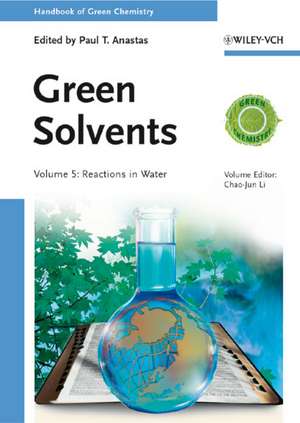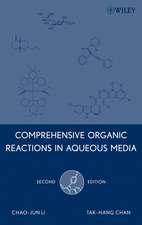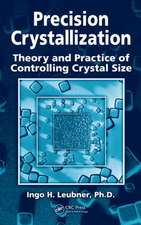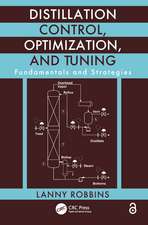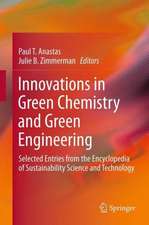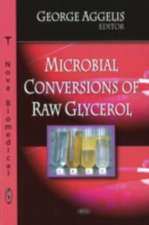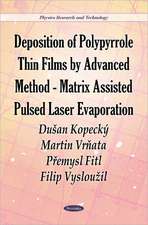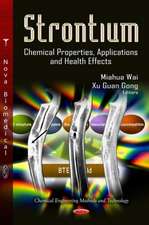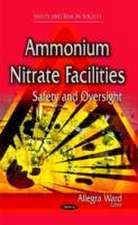Handbook of Green Chemistry – Green Solvents – Reactions in Water V 5: Handbook of Green Chemistry
Autor CJ Lien Limba Engleză Hardback – 13 aug 2013
Preț: 1037.51 lei
Preț vechi: 1206.40 lei
-14% Nou
Puncte Express: 1556
Preț estimativ în valută:
198.52€ • 207.29$ • 163.94£
198.52€ • 207.29$ • 163.94£
Carte disponibilă
Livrare economică 25 martie-08 aprilie
Livrare express 11-15 martie pentru 50.50 lei
Preluare comenzi: 021 569.72.76
Specificații
ISBN-13: 9783527325917
ISBN-10: 3527325913
Pagini: 436
Ilustrații: 2 farbige Abbildungen
Dimensiuni: 177 x 247 x 28 mm
Greutate: 0.95 kg
Ediția:Volume 5
Editura: Wiley Vch
Seria Handbook of Green Chemistry
Locul publicării:Weinheim, Germany
ISBN-10: 3527325913
Pagini: 436
Ilustrații: 2 farbige Abbildungen
Dimensiuni: 177 x 247 x 28 mm
Greutate: 0.95 kg
Ediția:Volume 5
Editura: Wiley Vch
Seria Handbook of Green Chemistry
Locul publicării:Weinheim, Germany
Public țintă
Organic Chemists, Catalytic Chemists, Chemical Industry, Environmental Chemists, Chemical Engineers, LibrariesNotă biografică
Series Editor: Paul T. Anastas joined Yale University as Professor and iserves as the Director of the Center for Green Chemistry and Green Engineering at Yale. From 2004-2006, Paul Anastas has been the Director of the Green Chemistry Institute in Washington, D.C. Until June of 2004 he served as Assistant Director for Environment at e White House Office of Science and Technology Policy where his responsibilities included a wide range of environmental science issues including furthering international public-private cooperation in areas of Science for Sustainability such as Green Chemistry. In 1991, he established the industry-government-university partnership Green Chemistry Program, which was expanded to include basic research, and the Presidential Green Chemistry Challenge Awards. He has published and edited several books in the field of Green Chemistry and developed the 12 principles of Green Chemistry. Volume Editor: Professor Chao-Jun Li received his Ph.D at McGill University (Montreal, Canada) and did a NSERC Postdoctoral Fellow at Stanford University (USA). He was on the faculty at Tulane University (New Orleans, USA) until 2003. Since 2003, he has been at McGill University where he currently holds a Canada Research Chair (in Green Chemistry) and an E. B. Eddy Chair Professorship. He has published over 300 scientific publications and received numerous awards including the US Presidential Green Chemistry Challenge Award and the Canadian Green Chemistry and Engineering Award. He is a Fellow of the Royal Society of Canada (Academy of Science) and is an Associate Editor for "Green Chemistry" of the Royal Society of Chemistry (UK).
Cuprins
THE PRINCIPLES OF AND REASONS FOR USING WATER AS A SOLVENT FOR GREEN CHEMISTRY Introduction Binding Two Species Together Driven by the Hydrophobic Effect in Water Aromatic Chlorination Acylation of Cyclodextrins by a Bound Ester Mimics of Metalloenzymes Using the Hydrophobic Effect in Water Mimics of the Enzyme Ribonuclease Mimics of Enzymes that Use Pyridoxamine Phosphate and Pyridoxal Phosphate as Coenzymes Artificial Enzymes Carrying Mimics of Thiamine Pyrophosphate Enolizations and Aldol Condensations Hydrophobic Acceleration of Diels-Alder Reactions Selectivities in Water Induced by the Hydrophobic Effect - Carbonyl Reductions Selectivities in Water Induced by the Hydrophobic Effect - Oxidations Using Hydrophobic Effects in Water to Determine the Geometries of Transition States for Some Important Reactions Conclusion GREEN ACID CATALYSIS IN WATER Introduction Lewis Acids in Water Chiral Lewis Acid-Catalyzed Asymmetric Reactions in Water Bronsted Acid Catalysis in Pure Water Conclusion and Perspective GREEN BASES IN WATER Introduction Types of Bases and Their Use from a Green Point of View Liquid-Liquid Processes Solid-Liquid Processes GREEN OXIDATION IN WATER Introduction Water-Soluble Ligands Oxidations Catalyzed by Metalloporphyrins and Metallophthalocyanines Epoxidation and Dihydroxylation of Olefins in Aqueous Media Alcohol Oxidations in Aqueous Media Aldehyde and Ketone Oxidations in Water Sulfoxidations in Water Conclusion GREEN REDUCTION IN WATER Introduction Water-Soluble Ligands Hydrogenation in Water Transfer Hydrogenation in Water Role of Water Conclusion COUPLING REACTIONS IN WATER Introduction Reaction of Carbonyl Compounds and Derivatives Reaction of Alkenes and Alkynes Reaction of Organic Halides and Derivatives Conclusion "ON WATER" FOR GREEN CHEMISTRY Introduction Pericyclic Reactions Addition of Heteronucleophiles to Unsaturated Carbonyl Compounds Enantioselective Direct Aldol Reactions Coupling Reactions Oxidation Bromination Reactions Miscellaneous Reactions Theoretical Studies Conclusion PERICYCLIC REACTIONS IN WATER. TOWARD GREEN CHEMISTRY Introduction Pericyclic Reaction in Aqueous Media Conclusion NON-CONVENTIONAL ENERGY SOURCES FOR GREEN SYNTHESIS IN WATER (MICROWAVE, ULTRASOUND, AND PHOTO) Introduction MW-Assisted Organic Transformations in Aqueous Media Sonochemical Organic Transformations in Aqueous Media Photochemical Transformations in Aqueous Media Conclusion FUNCTIONALIZATION OF CARBOHYDRATES IN WATER Introduction C-C Bond Formation Reactions C-N Bond Formation Reactions Functionalization of Hydroxy Groups Clyco-Organic Substrates and Reactions in Aqueous Sugar Solutions Conclusion WATER UNDER EXTREME CONDITIONS FOR GREEN CHEMISTRY Introduction Background Recent Progress in HTW Synthesis WATER AS A GREEN SOLVENT FOR PHARMACEUTICAL APPLICATIONS Introduction - Is Water a Green Solvent? Water-Based Enzymatic Processes Processes in Which the Product is Isolated by pH Adjustment to the Isoelectric Point Carbon-Carbon Bond-Forming Cross-Coupling Reactions in Water Pharmaceutical Processes Using Mixed Aqueous Solvents Conclusion WATER AS A GREEN SOLVENT FOR BULK CHEMICALS Introduction Hydroformylation - An Overview Water as Solvent for Hydroformylation Water as Solvent in the Production of 2,7-Octadien-1-ol (Kurayray Process) Conclusion
